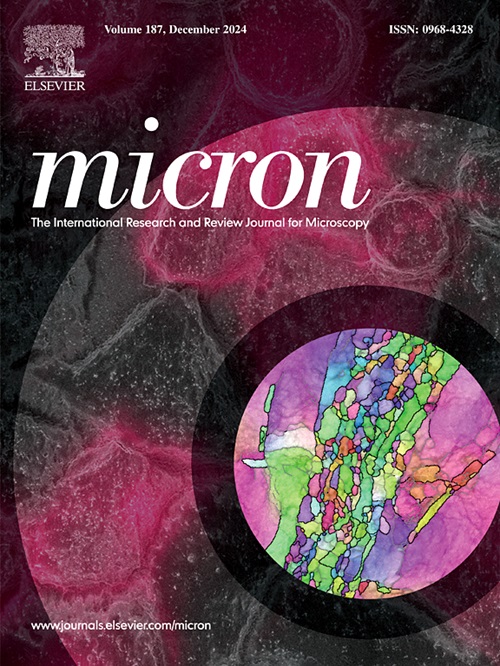Direct synthesis of multilayer graphene on a microscale ridge-patterned copper substrate
IF 2.2
3区 工程技术
Q1 MICROSCOPY
引用次数: 0
Abstract
Graphene’s exceptional physical properties, such as high thermal conductivity and mechanical strength, have attracted significant interest for its integration in transistors and thermal interface materials. While achieving various conformations of graphene is desirable for such applications, synthesizing graphene with target conformations remains a challenge. In this work, we present a method for synthesizing multilayer graphene with ridged conformations, using a microscale ridge-patterned copper (Cu) layer that was epitaxially deposited on a sapphire substrate. The Cu layer, patterned with channels using photolithography, guides the graphene growth to conform to the ridged structure of the Cu substrate. Uniform ridged multilayer graphene is grown on the Cu substrate, and can be transferred to transmission electron microscope (TEM) grids for observation. This method offers the potential for the controlled formation of ridge patterns in graphene and could be extended to synthesizing graphene with tunable conformations for applications in graphene-based devices, electrodes, or graphene grids for graphene liquid cells and cryogenic electron microscopy for high-throughput imaging.
在微尺度脊纹铜衬底上直接合成多层石墨烯。
石墨烯具有优异的物理性能,如高导热性和机械强度,其在晶体管和热界面材料中的集成引起了人们的极大兴趣。虽然实现石墨烯的各种构象对于此类应用是理想的,但合成具有目标构象的石墨烯仍然是一个挑战。在这项工作中,我们提出了一种合成具有脊状构象的多层石墨烯的方法,该方法使用外延沉积在蓝宝石衬底上的微尺度脊状铜(Cu)层。利用光刻技术绘制通道的铜层引导石墨烯生长,使其符合铜衬底的脊状结构。均匀脊状多层石墨烯生长在Cu衬底上,并可转移到透射电子显微镜(TEM)网格中进行观察。该方法提供了在石墨烯中控制脊状图案形成的潜力,并且可以扩展到合成具有可调构象的石墨烯,用于石墨烯基器件、电极或石墨烯液体电池的石墨烯网格以及用于高通量成像的低温电子显微镜。
本文章由计算机程序翻译,如有差异,请以英文原文为准。
求助全文
约1分钟内获得全文
求助全文
来源期刊

Micron
工程技术-显微镜技术
CiteScore
4.30
自引率
4.20%
发文量
100
审稿时长
31 days
期刊介绍:
Micron is an interdisciplinary forum for all work that involves new applications of microscopy or where advanced microscopy plays a central role. The journal will publish on the design, methods, application, practice or theory of microscopy and microanalysis, including reports on optical, electron-beam, X-ray microtomography, and scanning-probe systems. It also aims at the regular publication of review papers, short communications, as well as thematic issues on contemporary developments in microscopy and microanalysis. The journal embraces original research in which microscopy has contributed significantly to knowledge in biology, life science, nanoscience and nanotechnology, materials science and engineering.
 求助内容:
求助内容: 应助结果提醒方式:
应助结果提醒方式:


